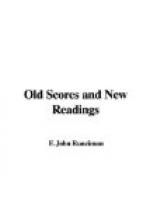After all, this is hardly surprising. Perfect art wants perfect listeners, and just now we are much too eager for excitement, too impatient of mere beauty, to listen perfectly to perfect music. And there are other reasons why “Don Giovanni” should not appeal to this generation. For many years it was the sport of the prima donna, and conductors and singers conspired to load it with traditional Costamongery, until at last the “Don Giovanni” we knew became an entirely different thing from the “Don Giovanni” of Mozart’s thought. Not Giovanni but Zerlina was the principal figure; the climax of the drama was not the final Statue scene, but “Batti, batti”; Leporello’s part was exaggerated until the Statue scene became a pantomime affair with Leporello playing pantaloon against Giovanni’s clown. Such an opera could interest none but an Elephant and Castle audience, and probably only the beauty of the music prevented it reaching the Elephant and Castle long ago. So low had “Don Giovanni” fallen, when, quite recently, serious artists like Maurel tried to take it more seriously and restore it to its rightful place. Only, unfortunately, instead of brushing away traditions and going back to the vital conception of Mozart, they sought to modernise it, to convert it into an early Wagner music-drama. The result may be seen in any performance at Covent Garden. The thing becomes a hodge-podge, a mixture of drama, melodrama, the circus, the pantomime, with a strong flavouring of blatherskite. The opera is largely pantomime—it was intended by Mozart to be pantomime; and the only possible way of doing it effectively is to accept the pantomime frankly, but to play it with such force and sincerity that it is not felt to be pantomime. And the real finale should be sung afterwards. Probably many people would go off to catch their trains. But, after all, Mozart wrote for those who have no trains to catch when this masterpiece, the masterpiece of Italian opera, is sung as he intended it to be sung.




